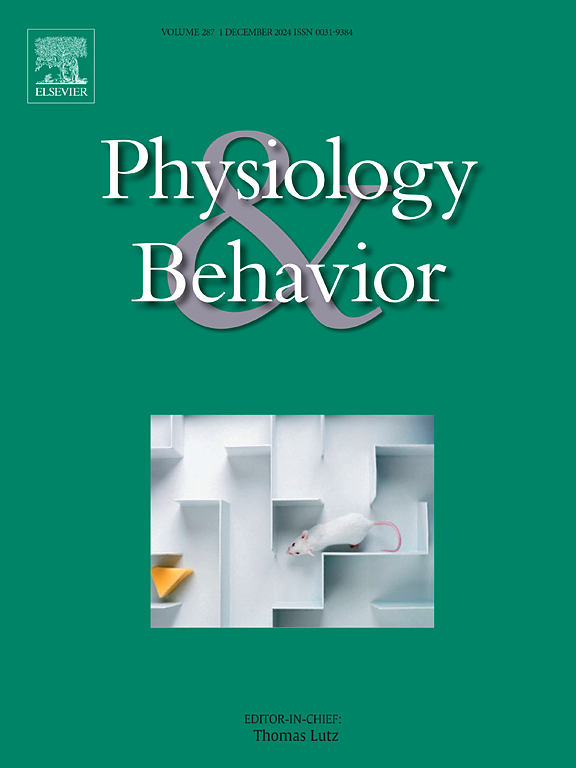New insights into individual differences in response to chronic unpredictable mild stress (CUMS) in rats with respect to hippocampal BDNF and GSK3-β expression levels
IF 2.4
3区 医学
Q2 BEHAVIORAL SCIENCES
引用次数: 0
Abstract
Preclinical and clinical studies have shown a wide-range of individual differences in response to stressors or novel environments which can affect the susceptibility to develop abnormal behaviors and neuropsychiatric disorders. Both vulnerability and resiliency have been observed in animals and humans experiencing stressful events. Chronic unpredictable mild stress (CUMS) is a rodent depression model consisting of various stressors. This protocol leads to depressive- and anhedonic-like behaviors in rodents. The present study aimed to evaluate potential individual differences in response to CUMS in rats, with respect to the expression level of brain-derived neurotrophic factor (BDNF) and glycogen synthase kinases 3-beta (GSK3-β) (proteins involved in the modulation of mood, neuroplasticity, and cognition) in the hippocampus. CUMS was performed for four consecutive weeks. Depressive-like behavior, locomotor activity, anxiety-like behavior, and pain threshold were also evaluated using forced swim test (FST), open field test (OFT), and the hot plate (HP), respectively. Real-time PCR was used to evaluate BDNF and GSK3-β expression levels. The results showed that CUMS rats can be classified as two clusters: affected and non-affected (depressed and non-depressed). Affected rats showed depressive- and anxiety-like behaviors, decreased locomotor activity, and increased pain threshold. However, non-affected rats were similar to controls. In addition, there was a downregulation of BDNF and upregulation of GSK3-β in affected rats. Spearman correlation analysis also showed a relationship between BDNF and GSK3-β expression levels with individual differences. In conclusion, the present study showed that BDNF and GSK3-β may be involved in individual differences in CUMS rats.
关于大鼠海马 BDNF 和 GSK3-β 表达水平对慢性不可预测轻度应激(CUMS)反应个体差异的新见解。
临床前和临床研究表明,个体对压力源或新环境的反应存在很大差异,这可能会影响异常行为和神经精神疾病的易感性。在经历应激事件的动物和人类身上,都观察到了易感性和恢复力。慢性不可预测轻度应激(CUMS)是一种由各种应激源组成的啮齿动物抑郁模型。这种方案会导致啮齿动物出现类似抑郁和失调的行为。本研究旨在评估大鼠对 CUMS 反应的潜在个体差异,包括海马中脑源性神经营养因子 (BDNF) 和糖原合酶激酶 3-beta (GSK3-β)(参与情绪、神经可塑性和认知调节的蛋白质)的表达水平。CUMS 连续进行了四周。此外,还分别使用强迫游泳试验(FST)、开阔地试验(OFT)和热板试验(HP)对抑郁样行为、运动活动、焦虑样行为和痛阈进行了评估。实时 PCR 被用来评估 BDNF 和 GSK3-β 的表达水平。结果显示,CUMS大鼠可分为两组:受影响和非受影响(抑郁和非抑郁)。受影响的大鼠表现出类似抑郁和焦虑的行为,运动活动减少,疼痛阈值升高。然而,未受影响的大鼠与对照组相似。此外,受影响大鼠的 BDNF 下调,GSK3-β 上调。斯皮尔曼相关分析还显示,BDNF 和 GSK3-β 表达水平之间存在个体差异。总之,本研究表明,BDNF和GSK3-β可能与CUMS大鼠的个体差异有关。
本文章由计算机程序翻译,如有差异,请以英文原文为准。
求助全文
约1分钟内获得全文
求助全文
来源期刊

Physiology & Behavior
医学-行为科学
CiteScore
5.70
自引率
3.40%
发文量
274
审稿时长
47 days
期刊介绍:
Physiology & Behavior is aimed at the causal physiological mechanisms of behavior and its modulation by environmental factors. The journal invites original reports in the broad area of behavioral and cognitive neuroscience, in which at least one variable is physiological and the primary emphasis and theoretical context are behavioral. The range of subjects includes behavioral neuroendocrinology, psychoneuroimmunology, learning and memory, ingestion, social behavior, and studies related to the mechanisms of psychopathology. Contemporary reviews and theoretical articles are welcomed and the Editors invite such proposals from interested authors.
 求助内容:
求助内容: 应助结果提醒方式:
应助结果提醒方式:


